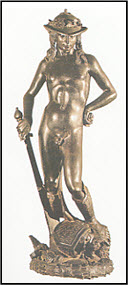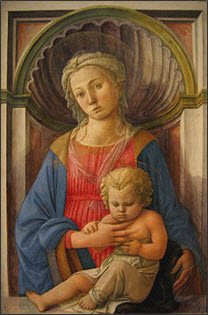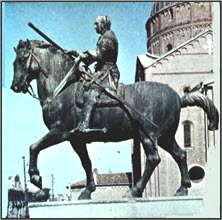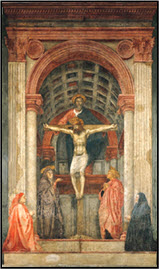


DONATELLO (Donato di Niccolo) c1386 -
(R2, H4, H5, H6)
xxxxxDonatello, who revived the classical style, is regarded as the founder of modern sculpture in both marble and bronze. His work is seen at its best in his life-
Including:
Masaccio and
Fra Filippo Lippi

aaaaaHaving studied in Rome for some years, the Italian sculptor Donatello is remembered above all for his revival of the classical style. He can be rightly regarded as the founder of modern sculpture in both marble and bronze. His work is seen at its best in his graceful bronze statue of the biblical hero  David, completed in 1435 -
David, completed in 1435 -
aaaaaHe was born in Florence and, as we have seen, he worked for a time as a student under Ghiberti, assisting in the making of his first set of bronze doors. One of his first individual works, a marble statue of David, clearly shows the influence of his former master. And, early on, he was also on good terms with Brunelleschi with whom he visited Rome in the early 1400s. His early sculpture owes much to his friend’s use of linear perspective, and story has it that the wooden crucifix in the church of Santa Croce was made as part of some good-
aaaaaHis early work in Florence, notably his marble statues of St. Mark and St. George and his seated figure of St. John the Evangelist, retain the influence of the Gothic style, but show a realism and a naturalism which were to become the hallmarks of his later work. His David and Gattamelata aside, his statues of the five prophets, made for the niches in the bell-
aaaaaAmong other major works are his delightful Cantoria (the Singer’s pulpit), made for Florence cathedral and now in its museum (illustrated centre below), and the elaborately decorated high altar, together with its beautiful bronze crucifix, made for the Paduan church of San Antonio. The altar’s framework is made of marble and limestone and adorned with seven life-
xxxxxAn artist strongly influenced by Donatello and Brunelleschi was Masaccio (1401-
aaaaaA contemporary artist who was strongly influenced by Donatello (and Brunelleschi) was the Italian painter Masaccio (1401-
xxxxxThe early work of the Florentine painter Fra Filippo Lippi (1406-
aaaaaThe Florentine painter Fra Filippo Lippi (1406-
 aaaaaBorn about 1406 and orphaned at an early age, Lippi was raised in the Carmelite monastery and became a monk at the age of 15. It was at this time that Masaccio was painting frescoes in the Brancacci chapel there, and this work made a deep impression upon him. The restricted, religious life did not suit his temperament, however, and he left in 1432 and led an adventurous five years before returning to Florence in 1437. Here, like many artists of the day, he served the Medici family, working in a number of the city’s churches and convents. A major work at this time was his altarpiece Coronation of the Virgin, now in the Uffizi gallery in Florence. This was crowded with figures and showed above all a sound mastery of the perspective format. It also broke new ground in that the scene was not divided up into a number of panels, but was painted as one continuous whole. Shown here is Madonna and Child, completed in 1445.
aaaaaBorn about 1406 and orphaned at an early age, Lippi was raised in the Carmelite monastery and became a monk at the age of 15. It was at this time that Masaccio was painting frescoes in the Brancacci chapel there, and this work made a deep impression upon him. The restricted, religious life did not suit his temperament, however, and he left in 1432 and led an adventurous five years before returning to Florence in 1437. Here, like many artists of the day, he served the Medici family, working in a number of the city’s churches and convents. A major work at this time was his altarpiece Coronation of the Virgin, now in the Uffizi gallery in Florence. This was crowded with figures and showed above all a sound mastery of the perspective format. It also broke new ground in that the scene was not divided up into a number of panels, but was painted as one continuous whole. Shown here is Madonna and Child, completed in 1445.
aaaaaBut perhaps his most outstanding altarpiece was his Madonna and Child with Scenes from the Life of Mary, a circular painting in the Pitta Palace, Florence, illustrating both his realism and the clarity of expression. In many of his works, as in the one illustrated above, he captures a grace and serenity not matched by many of his contemporaries. Among other works are his series of frescoes for the Cathedrals of Spoleto and Prato. It was while he was working at the Convent of Santa Margherita at Prato in 1456 that the wayward monk ran off with one of the nuns there, Lucrezia Buti. They were later married and their son, Filippino, also became a noted Florentine painter.
aaaaaIllustrated here (left to right) are Madonna of Humility, The Adoration of the Magi,
and The Vision of St. Augustine.



Acknowledgements
Donatello: David -
H6-
aaaaaHis last three years in Padua, 1453 to 1455, were not happy ones. He was ill for some time, and the two works he completed during this period clearly suggest the stress he was under. His wooden statue of St. John the Baptist, for the church of Santa Maria Gloriosa dei Frari in Venice, and his Mary Magdalene for the Florence baptistery, both thin and distorted, might well be the result of his distressed state of mind. His last years were happier, however, spent in his native city and once again in the service of the Medici family. By the time of his death in 1466, much of Italy had been strongly influenced by his work
 aaaaaIncidentally, Donatello’s famous equestrian statute of the Venetian mercenary leader Erasmo da Narni, nicknamed “Gattamelata” (Honeyed cat!), caused quite a stir when it was completed in about 1450. Dressed as he was in armour and holding up his baton of authority in his right hand, he was considered to be acting above his station. Up until that time such a statute and such a pose would have been reserved for rulers, not jumped-
aaaaaIncidentally, Donatello’s famous equestrian statute of the Venetian mercenary leader Erasmo da Narni, nicknamed “Gattamelata” (Honeyed cat!), caused quite a stir when it was completed in about 1450. Dressed as he was in armour and holding up his baton of authority in his right hand, he was considered to be acting above his station. Up until that time such a statute and such a pose would have been reserved for rulers, not jumped-

 aaaaaThese frescoes rank among his masterpieces, as does his Trinity fresco in Santa Maria Novello in Florence (illustrated here). In this work the linear perspective employed gives the illusion of the chapel receding far into the distance. His Madonna and Child Enthroned, painted for a church in Pisa, is in the National Gallery, London. Here again, we can see how the artist uses linear perspective and a single source of light to create the illusion of depth, and to direct the eye to the focal point. Such works played a major part in the art of painting during the Renaissance. The Italian art historian Giorgio Vasari observed that all the Florentine artists of the day studied his works “to learn the precepts and the rules for painting well”. Michelangelo for one is known to have copied some of the figures from his frescoes.
aaaaaThese frescoes rank among his masterpieces, as does his Trinity fresco in Santa Maria Novello in Florence (illustrated here). In this work the linear perspective employed gives the illusion of the chapel receding far into the distance. His Madonna and Child Enthroned, painted for a church in Pisa, is in the National Gallery, London. Here again, we can see how the artist uses linear perspective and a single source of light to create the illusion of depth, and to direct the eye to the focal point. Such works played a major part in the art of painting during the Renaissance. The Italian art historian Giorgio Vasari observed that all the Florentine artists of the day studied his works “to learn the precepts and the rules for painting well”. Michelangelo for one is known to have copied some of the figures from his frescoes.
aaaaaIncidentally, Masaccio’s real name was Tommaso di Ser Giovanni di Mone, but he was given the nickname “Slovenly Tom” because he was so dedicated to his art that he cared little about his appearance or personal affairs. If nothing else, it certainly shortened his name.

aaaaaSo highly valued was Lippi’s work that, when he died in 1469, the Medici had a splendid sepulchre erected in his honour. Designed by his son, Filippino, it can be seen in Spoleto cathedral. It proved a fitting tribute to a man whose painting was destined to have a marked influence upon the great Italian artist Sandro Botticelli.
